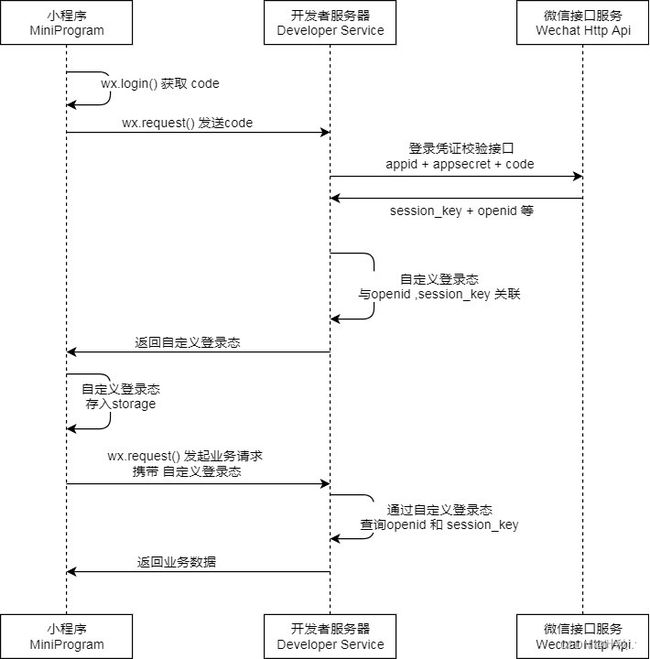“微信小程序登录与用户信息获取详解“
目录
- 引言
- 微信小程序微信登录介绍
-
- 1. 微信登录的基本概念
- 2. 微信小程序中的微信登录
- 微信小程序登录的wxLogin与getUserProfile的区别
-
- 1. wx.login()
- 2. wx.getUserProfile()
- 3.两者区别
- 微信小程序登录的理论概念
-
- 1. 微信登录流程
- 2. 用户授权与登录态维护
- 微信小程序登录的代码演示
-
- 1.getUserProfile登录
- 微信表情包存储问题解决
- 总结

引言
在现代社交网络的时代,微信小程序作为一种快速、便捷的应用工具,受到了越来越多的关注和使用。其中,微信登录功能是小程序中最常见且重要的功能之一。本篇博客将深入介绍微信小程序登录的相关概念和实现方式,并重点探讨微信登录与用户信息获取的区别与联系。
微信小程序微信登录介绍
1. 微信登录的基本概念
微信登录是指通过微信账号进行身份验证,使用户可以使用自己的微信账号登录到第三方应用或网站。微信登录减少了用户注册的繁琐过程,提供了更加便捷的登录体验。
2. 微信小程序中的微信登录
微信小程序中的微信登录功能允许用户使用微信账号登录小程序,并获取用户的基本信息。通过微信登录,小程序能够实现个性化的服务,提供更好的用户体验。
微信小程序登录的wxLogin与getUserProfile的区别
1. wx.login()
1.1. 功能介绍
wx.login() 是小程序提供的一个登录接口,用于获取用户的登录凭证 code。开发者可以通过该接口将 code 发送给服务器,以便获取用户的唯一标识 OpenID 和会话密钥 SessionKey。
1.2. 使用场景
wx.login() 适用于不需要获得用户详细信息的场景,比如只需要获取用户的 OpenID 进行身份验证等。
2. wx.getUserProfile()
2.1. 功能介绍
wx.getUserProfile() 是小程序提供的一个获取用户信息的接口,可以获取用户的基本信息,包括昵称、头像、性别等。开发者可以通过该接口获取用户的个人信息,实现更加个性化的服务。
2.2. 使用场景
wx.getUserProfile() 适用于需要获取用户详细信息的场景,比如在用户授权后需要显示用户的个人资料页面等。
3.两者区别
区别在与wx,login()调用了方法即可获取信息,而wx.getUserProfile()需要在本来点击允许后才能获得信息。
wx,login()不推荐使用
微信小程序登录的理论概念
1. 微信登录流程
微信登录流程包括用户点击登录按钮、小程序调用 wx.login() 获取 code、小程序向服务器发送 code 并获取用户凭证等步骤。本节将详细介绍微信登录的整个流程及各个环节的作用。
2. 用户授权与登录态维护
用户授权是微信登录中的重要环节,通过用户的授权,小程序可以获取用户的基本信息。同时,小程序需要维护登录态,以确保用户在重新打开小程序时仍然处于登录状态。
-
说明
- 调用 wx.login() 获取 临时登录凭证code ,并回传到开发者服务器。
- 调用 auth.code2Session 接口,换取 用户唯一标识 OpenID 、 用户在微信开放平台帐号下的唯一标识UnionID(若当前小程序已绑定到微信开放平台帐号) 和 会话密钥 session_key。
- 之后开发者服务器可以根据用户标识来生成自定义登录态,用于后续业务逻辑中前后端交互时识别用户身份。
-
注意事项
- 会话密钥
session_key是对用户数据进行 加密签名 的密钥。为了应用自身的数据安全,开发者服务器不应该把会话密钥下发到小程序,也不应该对外提供这个密钥。 - 临时登录凭证 code 只能使用一次
- 会话密钥
-
appId 作用说明
- appid 是微信账号的唯一标识,这个是固定不变的;
如果了解微信公众号开发的就需要注意一下,小程序的appid 和 公众号的appid 是不一致的
- appid 是微信账号的唯一标识,这个是固定不变的;
-
session_key 功能说明
微信客户端通过wx.getUserInfo()获取用户的信息
后台有时候也需要获取微信客户端的用户信息,因此,就需要利用session_key这个秘钥来从微信平台中获取
官方文档原文
签名校验以及数据加解密涉及用户的会话密钥 session_key。 开发者应该事先通过 wx.login 登录流程获取会话密钥 session_key 并保存在服务器。为了数据不被篡改,开发者不应该把 session_key 传到小程序客户端等服务器外的环境。
微信小程序登录的代码演示
1.getUserProfile登录
- 1.点击登录–>点击微信直接登录–>点击允许
// 推荐使用wx.getUserProfile获取用户信息,开发者每次通过该接口获取用户个人信息均需用户确认
// 开发者妥善保管用户快速填写的头像昵称,避免重复弹窗
wx.getUserProfile({
desc: '用于完善会员资料', // 声明获取用户个人信息后的用途,后续会展示在弹窗中,请谨慎填写
success: (res) => {
//console.log(res);
debugger
user.checkLogin().catch(() => {
user.loginByWeixin(res.userInfo).then(res => {
app.globalData.hasLogin = true;
debugger
wx.navigateBack({
delta: 1
})
}).catch((err) => {
app.globalData.hasLogin = false;
if(err.errMsg=="request:fail timeout"){
util.showErrorToast('微信登录超时');
}else{
util.showErrorToast('微信登录失败');
}
this.setData({
lock:false
})
});
});
},
fail: (res) => {
app.globalData.hasLogin = false;
console.log(res);
util.showErrorToast('微信登录失败');
}
});
}
user.checkLogin()方法检查之前有无登录情况
/**
* 判断用户是否登录
*/
function checkLogin() {
return new Promise(function(resolve, reject) {
if (wx.getStorageSync('userInfo') && wx.getStorageSync('token')) {
checkSession().then(() => {
resolve(true);
}).catch(() => {
reject(false);
});
} else {
reject(false);
}
});
}
如果没有登录过则会走异常方法然后调用loginByWeixin()方法携带code与用户信息请求后端
/**
* 调用微信登录
*/
function loginByWeixin(userInfo) {
return new Promise(function(resolve, reject) {
return login().then((res) => {
//登录远程服务器
util.request(api.AuthLoginByWeixin, {
code: res.code,
userInfo: userInfo
}, 'POST').then(res => {
if (res.errno === 0) {
//存储用户信息
wx.setStorageSync('userInfo', res.data.userInfo);
wx.setStorageSync('token', res.data.token);
resolve(res);
} else {
reject(res);
}
}).catch((err) => {
reject(err);
});
}).catch((err) => {
reject(err);
})
});
}
/**
* Promise封装wx.login
*/
function login() {
return new Promise(function(resolve, reject) {
wx.login({
success: function(res) {
if (res.code) {
resolve(res);
} else {
reject(res);
}
},
fail: function(err) {
reject(err);
}
});
});
}
后台拿到前台传过来的code和用户信息再拿到配好的密钥执行
(WxMaJscode2SessionResult result = this.wxService.getUserService().getSessionInfo(code);)访问微信服务器发送请求得到sessionKey和openId
然后再根据**WxUser user = userService.queryByOid(openId);**代码执行访问数据库查询有没有这个用户已登录的情况(查询有无记录)如果没有则会添加一个用户,如果有,那么修改访问时间
然后再根据userId去生成一个Token令牌
然后返回一个result
/**
* 微信登录
*
* @param wxLoginInfo
* 请求内容,{ code: xxx, userInfo: xxx }
* @param request
* 请求对象
* @return 登录结果
*/
@PostMapping("login_by_weixin")
public Object loginByWeixin(@RequestBody WxLoginInfo wxLoginInfo, HttpServletRequest request) {
//客户端需携带code与userInfo信息
String code = wxLoginInfo.getCode();
UserInfo userInfo = wxLoginInfo.getUserInfo();
if (code == null || userInfo == null) {
return ResponseUtil.badArgument();
}
//调用微信sdk获取openId及sessionKey
String sessionKey = null;
String openId = null;
try {
long beginTime = System.currentTimeMillis();
//
WxMaJscode2SessionResult result = this.wxService.getUserService().getSessionInfo(code);
// Thread.sleep(6000);
long endTime = System.currentTimeMillis();
log.info("响应时间:{}",(endTime-beginTime));
sessionKey = result.getSessionKey();//session id
openId = result.getOpenid();//用户唯一标识 OpenID
} catch (Exception e) {
e.printStackTrace();
}
if (sessionKey == null || openId == null) {
log.error("微信登录,调用官方接口失败:{}", code);
return ResponseUtil.fail();
}else{
log.info("openId={},sessionKey={}",openId,sessionKey);
}
//根据openId查询wx_user表
//如果不存在,初始化wx_user,并保存到数据库中
//如果存在,更新最后登录时间
WxUser user = userService.queryByOid(openId);
if (user == null) {
user = new WxUser();
user.setUsername(openId);
user.setPassword(openId);
user.setWeixinOpenid(openId);
user.setAvatar(userInfo.getAvatarUrl());
user.setNickname(userInfo.getNickName());
user.setGender(userInfo.getGender());
user.setUserLevel((byte) 0);
user.setStatus((byte) 0);
user.setLastLoginTime(new Date());
user.setLastLoginIp(IpUtil.client(request));
user.setShareUserId(1);
userService.add(user);
} else {
user.setLastLoginTime(new Date());
user.setLastLoginIp(IpUtil.client(request));
if (userService.updateById(user) == 0) {
log.error("修改失败:{}", user);
return ResponseUtil.updatedDataFailed();
}
}
// token
UserToken userToken = null;
try {
userToken = UserTokenManager.generateToken(user.getId());
} catch (Exception e) {
log.error("微信登录失败,生成token失败:{}", user.getId());
e.printStackTrace();
return ResponseUtil.fail();
}
userToken.setSessionKey(sessionKey);
log.info("SessionKey={}",UserTokenManager.getSessionKey(user.getId()));
Map<Object, Object> result = new HashMap<Object, Object>();
result.put("token", userToken.getToken());
result.put("tokenExpire", userToken.getExpireTime().toString());
userInfo.setUserId(user.getId());
if (!StringUtils.isEmpty(user.getMobile())) {// 手机号存在则设置
userInfo.setPhone(user.getMobile());
}
try {
DateFormat df = new SimpleDateFormat("yyyy-MM-dd");
String registerDate = df.format(user.getAddTime() != null ? user.getAddTime() : new Date());
userInfo.setRegisterDate(registerDate);
userInfo.setStatus(user.getStatus());
userInfo.setUserLevel(user.getUserLevel());// 用户层级
userInfo.setUserLevelDesc(UserTypeEnum.getInstance(user.getUserLevel()).getDesc());// 用户层级描述
} catch (Exception e) {
log.error("微信登录:设置用户指定信息出错:"+e.getMessage());
e.printStackTrace();
}
result.put("userInfo", userInfo);
log.info("【请求结束】微信登录,响应结果:{}", JSONObject.toJSONString(result));
return ResponseUtil.ok(result);
}
//
// Source code recreated from a .class file by IntelliJ IDEA
// (powered by Fernflower decompiler)
//
package cn.binarywang.wx.miniapp.api;
import cn.binarywang.wx.miniapp.bean.WxMaJscode2SessionResult;
import cn.binarywang.wx.miniapp.config.WxMaConfig;
import me.chanjar.weixin.common.error.WxErrorException;
import me.chanjar.weixin.common.util.http.RequestExecutor;
import me.chanjar.weixin.common.util.http.RequestHttp;
public interface WxMaService {
String GET_ACCESS_TOKEN_URL = "https://api.weixin.qq.com/cgi-bin/token?grant_type=client_credential&appid=%s&secret=%s";
String JSCODE_TO_SESSION_URL = "https://api.weixin.qq.com/sns/jscode2session";
WxMaJscode2SessionResult jsCode2SessionInfo(String var1) throws WxErrorException;
boolean checkSignature(String var1, String var2, String var3);
String getAccessToken() throws WxErrorException;
String getAccessToken(boolean var1) throws WxErrorException;
String get(String var1, String var2) throws WxErrorException;
String post(String var1, String var2) throws WxErrorException;
<T, E> T execute(RequestExecutor<T, E> var1, String var2, E var3) throws WxErrorException;
void setRetrySleepMillis(int var1);
void setMaxRetryTimes(int var1);
WxMaConfig getWxMaConfig();
void setWxMaConfig(WxMaConfig var1);
WxMaMsgService getMsgService();
WxMaMediaService getMediaService();
WxMaUserService getUserService();
WxMaQrcodeService getQrcodeService();
WxMaTemplateService getTemplateService();
WxMaAnalysisService getAnalysisService();
WxMaCodeService getCodeService();
WxMaJsapiService getJsapiService();
WxMaSettingService getSettingService();
WxMaShareService getShareService();
WxMaRunService getRunService();
WxMaSecCheckService getSecCheckService();
void initHttp();
RequestHttp getRequestHttp();
}
第二次登录
package com.zking.ssm.wxcontroller;
import java.math.BigDecimal;
import java.util.HashMap;
import java.util.Map;
import java.util.Random;
import com.zking.ssm.annotation.LoginUser;
import com.zking.ssm.model.WxUser;
import com.zking.ssm.service.UserTokenManager;
import com.zking.ssm.service.WxUserService;
import com.zking.ssm.util.ResponseUtil;
import lombok.extern.slf4j.Slf4j;
import org.slf4j.Logger;
import org.slf4j.LoggerFactory;
import org.springframework.beans.factory.annotation.Autowired;
import org.springframework.validation.annotation.Validated;
import org.springframework.web.bind.annotation.*;
import com.alibaba.fastjson.JSONObject;
import javax.servlet.http.HttpServlet;
import javax.servlet.http.HttpServletRequest;
/**
* 用户服务
*/
@Slf4j
@RestController
@RequestMapping("/wx/user")
@Validated
public class WxUserController {
@Autowired
private WxUserService userService;
/**
* 用户个人页面数据
*
* @param userId
* 用户ID
* @return 用户个人页面数据
*/
@GetMapping("index")
public Object list(@LoginUser Integer userId, @RequestHeader("X-OA-token") String token) {
log.info("【请求开始】用户个人页面数据,请求参数,userId:{}", userId);
log.info("【请求开始】用户个人页面数据,请求参数,token:{}", token);
if (userId == null) {
log.error("用户个人页面数据查询失败:用户未登录!!!");
return ResponseUtil.unlogin();
}
WxUser wxUser = userService.selectByPrimaryKey(userId);
Map<Object, Object> data = new HashMap<Object, Object>();
data.put("metting_pubs", wxUser.getUserLevel());
data.put("metting_joins",wxUser.getUserLevel());
return ResponseUtil.ok(data);
}
}
微信表情包存储问题解决
mysql的utf8编码的一个字符最多3个字节,但是一个emoji表情为4个字节,所以utf8不支持存储emoji表情。但是utf8的超集utf8mb4一个字符最多能有4字节,所以能支持emoji表情的存储。
Linux系统中MySQL的配置文件为my.cnf。
Winows中的配置文件为my.ini。
utf8改为utf8mb4
[mysql]
# 设置mysql客户端默认字符集
default-character-set=utf8mb4
[mysqld]
#设置3306端口
port = 3306
# 设置mysql的安装目录
basedir=D:\\tools\\mysql-5.7.23-winx64
# 设置mysql数据库的数据的存放目录
datadir=D:\\tools\\mysql-5.7.23-winx64\\data
# 允许最大连接数
max_connections=200
# 服务端使用的字符集默认为8比特编码的latin1字符集
character-set-server=utf8mb4
# 创建新表时将使用的默认存储引擎
default-storage-engine=INNODB
总结
本篇博客深入介绍了微信小程序登录的相关概念和实现方式,并重点探讨了微信登录与用户信息获取的区别与联系。通过对微信登录流程、用户授权与登录态维护的理论概念进行解析,结合代码演示和表情包存储问题的解决方案,希望能够帮助开发者更好地理解和应用微信小程序登录功能。

